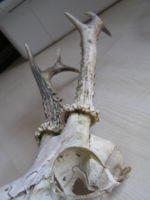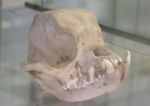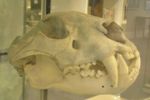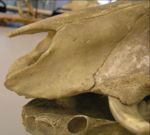Skull and Facial Muscles - Anatomy & Physiology
Introduction
The skull is divided into three components- the neurocranium, the dermatocranium and the viscerocranium. The skull also includes the hyoid apparatus, mandible, ossicles of the middle ear and the cartilage of the larynx, nose and ear. The skull protects the brain and head against injury and supports the structures of the face. In some animals the skull is also used for defensive actions, for example in horned ungulates such as red deer stags.
The neurocranium develops from the neural crest and mesoderm and undergoes endochondral ossification. It lies ventral to the brain.
The dermatocranium lies dorsal to the brain and develops from the neural crest and mesoderm. It undergoes intramembranous ossification.
The viscerocranium is the pharyngeal skeleton. It is derived only from the neural crest and undergoes endochondral and intramembranous ossification.
Structure
- The skull is made of many smaller bones
- Most of the skull bones are paired
- Cartilage or fibrous tissue separates the bones of the skull in the young animal
- Once growth has ceased, the sutures begin to ossify
Function
- Protection of brain
- Support facial muscles by providing origin and insertion sites
- Foramen provide entry and exit places for the vasculature and nervous system
- Defense
Bones of the Skull
Occipital Bone
Sphenoid Bone
Temporal Bone
Frontal Bone
Parietal Bone
Ethmoid Bone
Nasal Bone
Lacrimal Bone
Zygomatic Bone
Maxilla
Incisive Bone
Palatine Bone
Vomer
Pterygoid Bone
Mandible=
Species Differences
Canine
- Dogs have different skull lengths depending on breed
- Mesocephalic dogs have average conformation
- Dolichocephalic dogs have longer skull lengths
- Brachycephalic dogs have shorter skull lengths
- 2 halves of the mandible do not fuse allowing some movement
Feline
- The mandible appears globular in shape
- Large orbits with complete bony margins
- Large tympanic bulla which can be palpated
- 2 halves of the mandible do not fuse allowing some movement
- Weak sagittal crest
Equine
- Weak sagittal crest
- Long skull length
- Orbit placed more laterally with a complete bony rim
- Strong zygomatic arch which continues on to form the facial crest
- Deep nasoincisive notch
- Prominent hamular process
- Large mandible
- Vascular notch on mandible
- High ramus
Ruminant
- Skull is short and wide
- Cornual process on frontal bone
- Prominent temporal line
- Elevated orbital ring which is complete
- No facial crest
- Prominent tympanic bullae
- Nasoincisive notch present
Porcine
- Thick nucal crests
- Prominent temporal line
- Orbit is incomplete and small
- Strong and deep zygomatic arch
- Large tympanic bullae
- High caudal part of the skull
Avian
- Pneumatised skull bones
- Spaces in skull bones which connect to airways in the head rather than the air sacs
- Large orbits
- Skull plates are separated by spongy bone
- A single occipital condyle articulates with the atlas allowing more rotation of the head
- In parrots, the nasal bone and frontal bone are joined by a flexible cartliage structure allowing greater jaw opening which is called the craniofacial hinge. This allows kinesis to occur.
- Thin jugal arch (equivalent to zygomatic arch)
- Middle ear contains only the columella (equivalent to the stapes)





